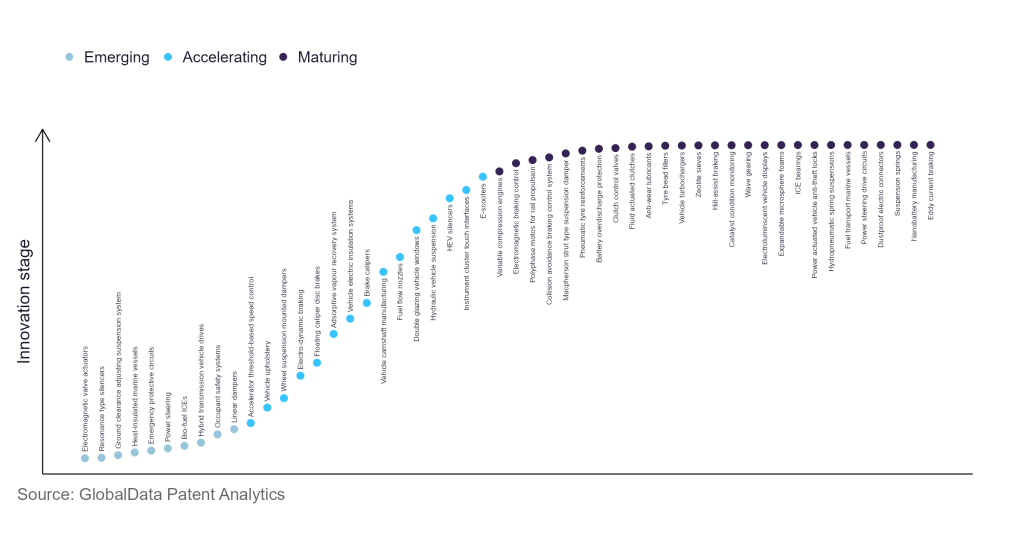The automotive industry continues to be a hotbed of innovation, with activity driven by the need to reduce traffic-related deaths, public awareness of transportation safety, increased demand for traction control, and the growing importance of technologies such as sensors, artificial intelligence, Internet of Things and machine learning. In the last three years alone, there have been over 1.2 million patents filed and granted in the automotive industry, according to GlobalData’s report on Innovation in Automotive: Anti-lock braking system (ABS). Buy the report here.

Discover B2B Marketing That Performs
Combine business intelligence and editorial excellence to reach engaged professionals across 36 leading media platforms.
However, not all innovations are equal and nor do they follow a constant upward trend. Instead, their evolution takes the form of an S-shaped curve that reflects their typical lifecycle from early emergence to accelerating adoption, before finally stabilising and reaching maturity.
Identifying where a particular innovation is on this journey, especially those that are in the emerging and accelerating stages, is essential for understanding their current level of adoption and the likely future trajectory and impact they will have.
290+ innovations will shape the automotive industry
According to GlobalData’s Technology Foresights, which plots the S-curve for the automotive industry using innovation intensity models built on over 619,000 patents, there are 290+ innovation areas that will shape the future of the industry.
Within the emerging innovation stage, eccentric crankshaft gears, retarder brake system, and closed-circuit liquid cooling are disruptive technologies that are in the early stages of application and should be tracked closely. Bio-fuel ICEs, electromagnetic valve actuators, and road friction estimation are some of the accelerating innovation areas, where adoption has been steadily increasing. Among maturing innovation areas are tyre bead fillers and vehicle turbochargers, which are now well established in the industry.
Innovation S-curve for the automotive industry

Anti-lock braking system (ABS) is a key innovation area in automotive
Anti-lock braking systems (ABS) assist in steering by creating improved traction in an emergency stop. It aids in preventing wheel locking so that the driver can potentially steer to safety. ABS does not help in shortening the stopping distance and may lead to vibration or push back of the pedal.
GlobalData’s analysis also uncovers the companies at the forefront of each innovation area and assesses the potential reach and impact of their patenting activity across different applications and geographies. According to GlobalData, there are 30+ companies, spanning technology vendors, established automotive companies, and up-and-coming start-ups engaged in the development and application of anti-lock braking system (ABS).
Key players in anti-lock braking system (ABS) – a disruptive innovation in the automotive industry
‘Application diversity’ measures the number of different applications identified for each relevant patent and broadly splits companies into either ‘niche’ or ‘diversified’ innovators.
‘Geographic reach’ refers to the number of different countries each relevant patent is registered in and reflects the breadth of geographic application intended, ranging from ‘global’ to ‘local’.
Hitachi is one of the leading patent filers in anti-lock braking systems (ABS). Hitachi Astemo Americas has recently developed a new technology called the antilock braking sensor, which reduces stopping distances and allows you to maintain steering control for longer periods of time. Effective braking necessitates precise monitoring of the speed and rotation of the wheels. Some other key patent filers in the innovation area include Toyota, Honda, Hyundai, NTT, etc.
To further understand the key themes and technologies disrupting the automotive industry, access GlobalData’s latest thematic research report on Automotive.
Data Insights
From

The gold standard of business intelligence.
Blending expert knowledge with cutting-edge technology, GlobalData’s unrivalled proprietary data will enable you to decode what’s happening in your market. You can make better informed decisions and gain a future-proof advantage over your competitors.





